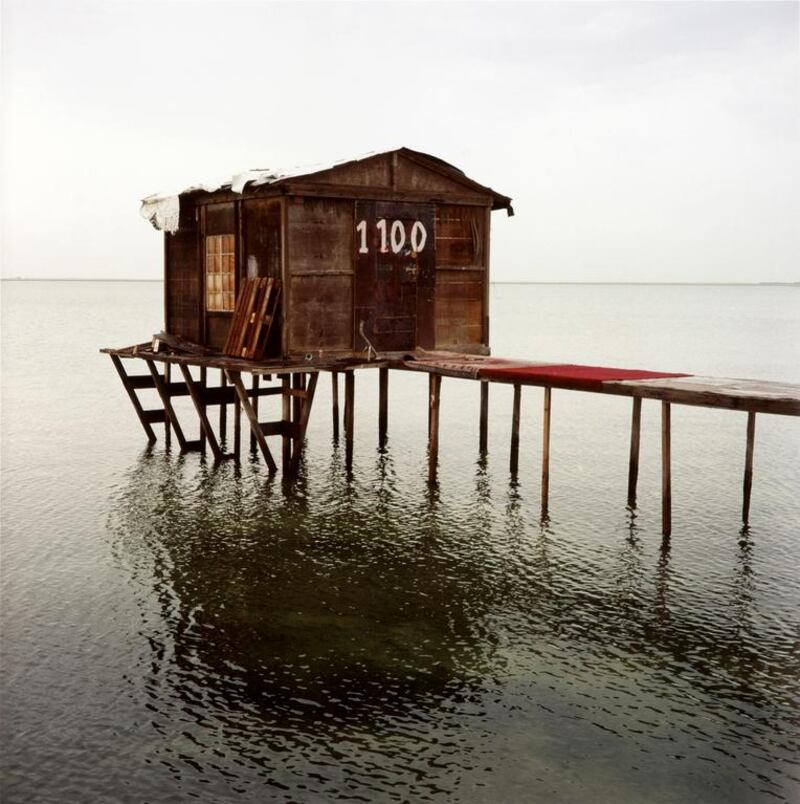It’s a Sunday evening in the industrial district of Shuwaikh, Kuwait’s answer to Dubai’s Al Quoz, and stylish patrons are steadily trickling into Life Center. It is a low-key mall, except on the second floor is one of Kuwait’s leading art spaces: Contemporary Art Platform Kuwait.
It's the opening night for two new exhibitions. In the main space, the Barjeel Art Foundation from Sharjah presents Al Seef, an exhibition of works from the personal collection of founder Sheikh Sultan Sooud Al Qassemi, and in the secondary space is The Replacement by the Iraqi artist Mahmoud Obaidi, who showed the exhibition in Dubai's Meem Gallery last year.
It is Barjeel’s debut exhibition in Kuwait and almost 200 people are at the opening, which, according to local art enthusiasts, is an unprecedented number.
But numbers aside, the quality of the artwork speaks for itself.
Al Seef, a colloquial Arabic term meaning water's edge, explores periods in history where proximity to water has either shaped or played a significant role in the development of a place: the establishment of folklore traditions on the Nile; the building of the Aswan High Dam and its implications; political confrontations on the banks of the Tigris; movement of Tangier's inhabitants through the Strait of Gibraltar; and transformation of coastal landscapes in the Gulf.
Upon entering the surprisingly large space, the first work the viewer is drawn to is Adam Henein's 1969 bronze statue Marie Nilus. This minimalist sculpture poetically weaves together two tales of creation: the ancient Egyptian legend that says all life stemmed from the River Nile and the narrative of Jesus's mother Mary.
“Both stories denote motherhood and giving birth,” says Suheyla Takesh, the show’s curator. “In this one sculpture, which has a human form but fin-like protrusions on the back, Henein interweaves culturally and historically significant references to Egypt and universal themes.”
Takesh included a secondary work from Henein to underline the artist's importance when discussing these stories. His Papyrus, from 1992, evokes the river through the artist's choice of medium – papyrus paper.
Moving forward several centuries, the modern Egypt section focuses on the story of the Aswan Dam through works by Ragheb Ayad and Effat Nagy.
“The building of the Aswan Dam was a hugely political statement,” says Al Qassemi. “It was initiated by Gamal Abdel Nasser and his new government following the 1952 revolution, and this artwork was part of a propaganda programme.”
Ayad and Nagy were part of a contingent of artists sent by the Egyptian Ministry of Culture to witness the building of the Aswan Dam and to paint what they saw.
Ayad’s work focuses on the massive manual labour force it took to construct the dam. In his piece, no hands are idle, and the rhythm and toil of the workers is made clear through the work’s many layers. Nagy’s piece is more abstract and slightly sinister: black lines slice through the canvas and depict the onset of an industrial age.
Interestingly, both these works are placed against Rafaat Ishak's Nomination for the Presidency of the New Egypt, a work from 2012. The piece is a fictional manifesto for a post-Hosni Mubarak Egypt in which the artist suggests, among other things, a deconstruction of the Aswan Dam.
“It is as if he wants to erase Egypt’s turbulent history and start again with a clean slate,” says Al Qassemi. “He is proposing the reversal of everything that has already been done.”
Other narratives that Takesh picked up on for this exhibition include the fierce and bloody battles fought on Iraqi soil. In Nazir Yahya's art, the Tigris is a witness to the carnage. In his 2010 collection, O' Tigris, the river is the sole subject.
Where generations before him painted the banks of the Tigris and celebrated its beauty, the Tigris in Yahya’s work has a more macabre undercurrent – last year several corpses were pulled out of the river, all victims of war crimes. Fish and hooks feature prominently in the collection, alongside shadowy faces of men.
Last is the Gulf section, where photographic works portray the relationship between man and water. In Camille Zakharia's Coastal Promenade, a series of makeshift fishing huts has been photographed, capturing a way of life under threat and immortalising accidental architecture. The series won the Golden Lion award for Best National Participation at the 2010 Venice Architecture Biennale.
“This could be anywhere in the Gulf,” a visitor says as she stares at the images with nostalgia in her eyes. “It reminds me of growing up.”
Ziad Antar's Portrait of a Territory – images taken between 2004 and 2011 along the coast of the UAE – also capture a time gone by.
“I chose this subject at first because I was interested in finding new ways to present the Barjeel collection,” says Takesh, “ but I realise now it is a subject so many people relate to because water is a great connector.”
• Al Seef runs until March 31 at Contemporary Art Platform Kuwait. For more details, visit capkuwait.com
aseaman@thenational.ae





